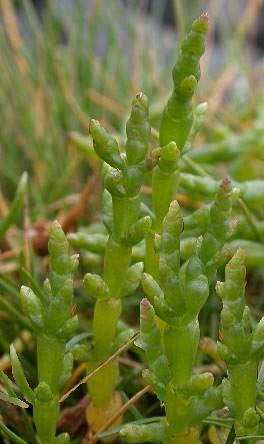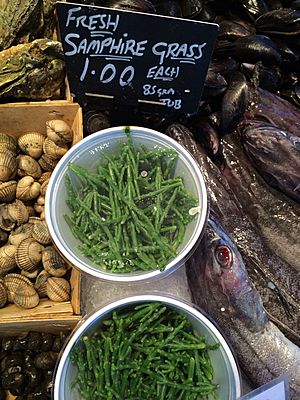Samphire facts for kids

Samphire is a name given to several types of juicy plants. These plants are special because they can grow in salty places, often near the sea or other water bodies. They are sometimes called "salty plants" or "sea vegetables."
Contents
What is Samphire?
There are different kinds of plants known as samphire:
- Rock samphire (Crithmum maritimum) grows on rocky coasts. It has white flowers and is found in places like Ireland and the United Kingdom. This is likely the plant mentioned by William Shakespeare in his play King Lear.
- Golden samphire (Limbarda crithmoides) is another coastal plant. It has yellow flowers and grows across Europe and Asia.
- Marsh samphire refers to several species in the Salicornia group. These are common in marshy areas in Britain.
- Other types include Blutaparon vermiculare in North and Central America, Tecticornia in Australia, and Sarcocornia, which is found worldwide.
After the Channel Tunnel was built, a nature park was made from the dug-out rock near Folkestone. This park was named "Samphire Hoe" because of these plants.
Why is it Called Samphire?
The name "samphire" comes from an old French name, "Saint Pierre." This means "Saint Peter." Samphire was named after Saint Peter, who is known as the special saint for fishermen. This is because the first plants called samphire grew in rocky, salty areas along the coast of northern Europe, or in coastal marshes. Sometimes, samphire is also called rock samphire or seafennel. In North Wales, especially near the River Dee marshes, it has been known as "sampkin" for a long time.
How People Use Samphire

Samphire for Food
Many types of samphire can be eaten. In England, people used to gather the leaves early in the year. They would pickle them or eat them in salads with oil and vinegar.
Rock samphire, also called sea fennel, is another edible kind. It is mentioned in Shakespeare's play King Lear:
Half-way down Hangs one that gathers samphire; dreadful trade!
This quote talks about how dangerous it was to collect rock samphire from tall sea cliffs.
Aboriginal Australians have eaten samphire for a long time. They use it as a wild food, also known as "bush tucker." This is because there is a lot of it, it tastes good, and it is healthy. Samphire is rich in Vitamin A and has good amounts of calcium and iron. Recently, other Australians have also started to use samphire as a food. You can now find it on restaurant menus across Australia.
A type of rock samphire called Paccasasso del Conero, or sea fennel, is popular in Italy. It grows along the Adriatic coast. This samphire is often used in local dishes. For example, it can be found in a sandwich with mortadella sausage, in pasta with mussels, or in fresh salads.
Samphire for Other Things
The ashes from marsh samphire were once used to make soap and glass. This is why it was also called "glasswort" a long time ago. The ashes had a special ingredient called sodium carbonate, also known as soda ash. In the 1300s, glassmakers built their workshops near where this plant grew. This shows how important samphire was for making glass.
Scientists have also looked at marsh samphire (specifically Salicornia bigelovii) as a possible source for biodiesel. Biodiesel is a type of fuel. The great thing is that this plant can grow in coastal areas where regular crops cannot.

